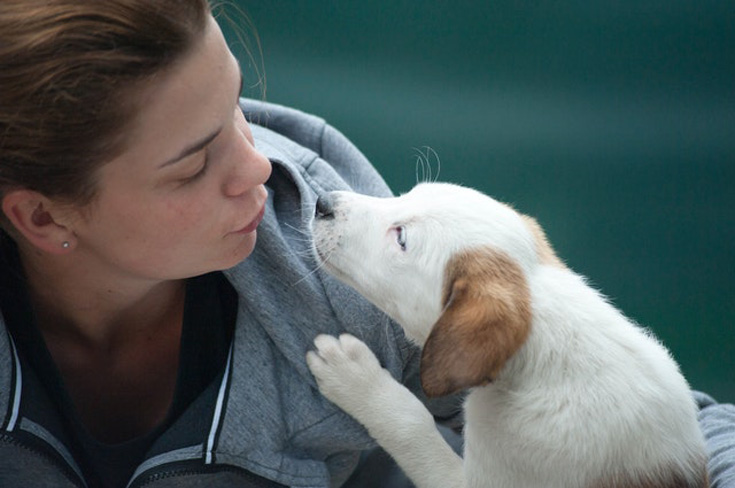If you’ve got a particularly anxious pup, you probably know how much of a headache it can be taking them someplace new. Car rides, vacations, or maybe just being out in public: anything that breaks their routine can set off a chorus of whines and barks.

A stressed dog means more stress for you, and nobody likes the feeling of stressing out your pet in the first place. An anxious dog is more likely to bark, growl, or in the worst case snap at something, making keeping your dog calm a crucial skill for any owner. Here are a few tips for keeping your dog calm whenever they’re in a new place.
Focus on the Familiar
If you’ve brought your dog out somewhere in public, there are going to be a ton of new people around, along with new sights and smells. The whole experience can quickly become sensory overload for an anxious dog, so bring along a few familiar items for them to have. A blanket from home carries the calming scent of their den and makes your dog feel comfortable and safe.
You are also familiar with your dog, so be sure to give them lots of attention while you’re out. Reinforce calm behavior with praise and treats to build up your dog’s comfort and encourage them to remain calm in new places in the future.
Be Prepared In The Car
Some dog owners just dread car trips. Depending on your dog’s personality, there may simply be no great way to keep them calm in the car, particularly if you’re the only one in the car with them. To mitigate your pet’s stress, be sure to stop frequently to exercise and spend some face-to-face time with them. If you have the option, having someone with you to interact with the dog while you drive is often helpful.
In the days leading up to a long car trip, you may want to acclimate your dog to the car gradually; go for short jaunts around the neighborhood with them until they’re comfortable sitting calmly in the car.
Bring Heavy-Duty Treats
One way to keep your dog focused on you and sitting still is to bring some high-power treats. New situations are the time to bring along the strongest, most enticing treats you have so that your pup is laser-focused on you—ground beef, chicken, peanut butter, or anything you know your dog will do anything for.
A delicious treat is a great way to keep your dog’s mind off of the inherent stress of being out and about in unfamiliar territory, and that goes double for places like the vet that they might be scared of in the first place.
Go Over The Counter
There are a number of products available over the counter that can help keep your dog calm in stressful situations. Collars with calming pheromones give your dog an olfactory message that everything is fine and they are safe. Some dogs respond well to classical music; you can find collections of music on CD or on streaming services that are curated specifically for relaxing dogs.
There are also many varieties of medicated treats, such as CBD treats from Joy Organics, or treats that contain ingredients like chamomile and Tryptophan. Try a few different types until you find something that works for your pet.
Train For It
Good training is essential for a healthy relationship with any dog. Commands like “sit,” “down,” and “stay” are useful in many situations, but you won’t have much luck if you’re only trying to use them in scenarios where your dog is anxious or excited. Practice handling every day and get your dog used to basic commands.
Then, when you need your dog to sit and be calm, go through their routine as exactly as possible. This is doubly beneficial because you’re bringing your dog under control directly while working through a familiar routine with them, which will help them acclimate and feel comfortable in their environment.
Stay Calm Yourself
Your dog’s emotional state is partially dependent on you, their owner. They see you as the pack leader, and if you’re worried about something, they, as part of the pack, will think they ought to be worried too. Unfortunately, this happens even if what you’re anxious about is your dog’s behavior.
If you want your dog to remain calm, you’ll want to stay calm yourself. Even if they’re acting up a little, keep your tone even and your manner steady. Play familiar games like tug or fetch, take them through tricks they know, and find ways to bring their routine into the new space.
Avoid being overly coddling or saying something like “you’re okay” over and over again. Your dog may interpret this unusual behavior from you as meaning there is something they ought to be worried about.
As you may have noticed, the big takeaway for making your dog feel at ease in a new place is to bring as much of their regular routine with them as possible. Familiar scents, sounds, and people will keep your dog from getting too anxious, and familiar tricks and routines can distract them if being out and about has them too overwhelmed.
Remember to stay calm yourself, because your dog takes emotional cues from your behavior. Try to stay as consistent as possible with how your routines work at home, and your dog will respond accordingly when you’re on the road or out in public.





Leave a Reply